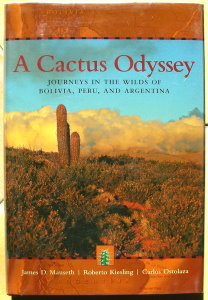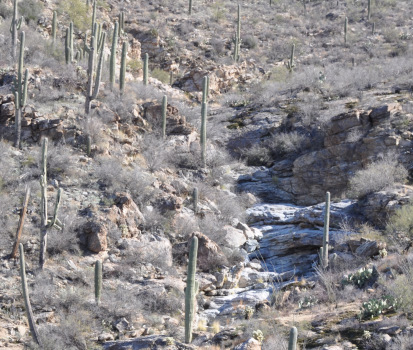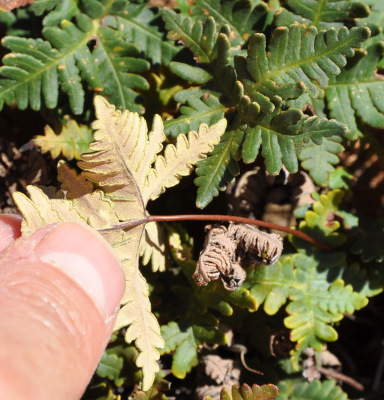Nature Book Review #5: A Cactus Odyssey
January 6, 2009
Fifth in an occasional series of natural history book reviews. I choose special favorites that I own and use regularly, but they might not be readily available in your local bookstore or library. Books reviewed here can be purchased through Amazon.com by following the links from my Southern Arizona Desert Botany homepage.
A Cactus Odyssey: Journeys in the Wilds of Bolivia, Peru, and Argentina. By James D. Mauseth, Roberto Kiesling, and Carlos Ostolaza. 2002, Timber Press, 306 pages, hardbound.

A Cactus Odyssey
For people who are still contemplating several weeks or months of cold, wet weather, this book is a cheerful winter reading selection. It’s an informal, non-technical, and entertaining natural history travelogue written by three botanists who journeyed throughout South America to study cacti. Most of the cacti and other plants in this region are poorly known, and some have been so little studied that they do not even have well-established scientific names. This book is packed with beautiful photos of spectacular and often bizarre cacti, and is full of interesting scientific tidbits and thought-provoking speculations that will inspire any naturalist. The authors present fascinating details about the flowers and growth habit of many species, and explore questions of habitat, distribution, and evolution. They do not just present disconnected facts, but communicate their curiosity and deep respect for their chosen field of study and for the land through which they travel. If you are already a cactus expert, this account will renew your appreciation for one of the most distinctive families of New World plants. If you aren’t botanically inclined and your interest in nature is more general, this book will awaken your sense of wonder at the diversity and tenacity of life.
Ferns under the Saguaros
January 1, 2009
We spent the past two days hiking on a couple of popular trails in the Rincon Mountains near Tucson. It’s unusual for us to hike where there is a trail at all, and even rarer that we go to the busy trailheads near town, but at this time of year, cold weather and short days limit our choices to short drives and the warmest places. Many of the rocky canyons in the saguaro-covered lower parts of the Rincons are singing and shining with running water as the snow melts in the pine-forested highlands. The water is not a stranger here – it completes the landscape and makes it come alive. Even small canyons like the one pictured below, where water usually only flows when it’s actually raining, shelter the “resurrection” ferns and spikemoss that are green and growing now.

Canyon in the Rincons

Star Fern with Jatropha
When identifying desert ferns, it’s important to look at the underside of the leaf, since many species have distinctive hair, scales, or – in this case – a coating of yellowish waxy farina on the lower surface. Stems are extremely brittle, so great care is needed when handling the leaves so as not to break them off:

Star Fern Underside
I love the beautiful pinkish-golden powder coating. It fades to nearly white on older leaves. The coating is characteristic of the genus Notholaena and helps keep the leathery leaf from drying out too fast. It also reflects the sunlight to keep the leaf from buring, since the underside is exposed when the leaves are dry and curled up. There is a dried leaf, curled like a tiny hand (still alive, just not yet revived) in the center of the photo.
Besides fernhunting, we also greeted the saguaros, admired the lush “forest” of jojoba bushes, and pointed out five species of cholla to curious hikers.